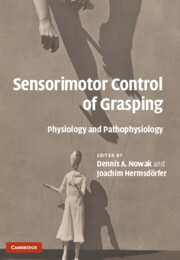Book contents
- Frontmatter
- Contents
- List of contributors
- Preface
- Part I Methodology
- Part II The physiology of grasping
- 10 The study of hand movements during grasping. A historical perspective
- 11 Sensory control of object manipulation
- 12 Predictive mechanisms and object representations used in object manipulation
- 13 The neurohaptic control of the hand
- 14 Points for precision grip
- 15 Two hands in object-oriented action
- 16 Dynamic grasp control during gait
- 17 Development of grasping and object manipulation
- 18 The effects of aging on sensorimotor control of the hand
- Part III The pathophysiology of grasping
- Part IV Therapy of impaired grasping
- Index
- Plate section
- References
16 - Dynamic grasp control during gait
Published online by Cambridge University Press: 23 December 2009
- Frontmatter
- Contents
- List of contributors
- Preface
- Part I Methodology
- Part II The physiology of grasping
- 10 The study of hand movements during grasping. A historical perspective
- 11 Sensory control of object manipulation
- 12 Predictive mechanisms and object representations used in object manipulation
- 13 The neurohaptic control of the hand
- 14 Points for precision grip
- 15 Two hands in object-oriented action
- 16 Dynamic grasp control during gait
- 17 Development of grasping and object manipulation
- 18 The effects of aging on sensorimotor control of the hand
- Part III The pathophysiology of grasping
- Part IV Therapy of impaired grasping
- Index
- Plate section
- References
Summary
Summary
When transporting an object during locomotion, the inertial forces that are indirectly generated through the motion of multiple body parts must be taken into account to prevent object slippage. The grip–inertial force coupling that maintains a secure grasp on a hand-held object is preserved across a variety of locomotor tasks that include variations in velocity and precision demands (e.g. transporting a cup of water). When the locomotor pattern is altered by changing the step length or stepping over an obstacle, the grip–inertial force coupling continues to be under anticipatory control. However, the coupling is less robust and can be explained by increased attention demands. Furthermore, the fine motor grasping functions and gross motor locomotor functions are precisely coordinated across multiple limb segments to ensure successful performance right from the onset of gait initiation. These findings support the notion that grip force is based on moment-to-moment predictions of inertial forces acting on the object at gait initiation and throughout predictable variations in the gait cycle. Internal representations of the interactions between body segments through which inertia is transferred to the object–digit interface are proposed to provide the basis for this anticipatory grip force control.
Introduction
A central question in the study of systems motor control is how simultaneous tasks involving multiple body segments are coordinated. For example, during voluntary movements with a hand-held object, grip (normal) force is coupled to the object's load as well as to the motion-induced inertial (tangential) force in an anticipatory manner to prevent slippage.
Information
- Type
- Chapter
- Information
- Sensorimotor Control of GraspingPhysiology and Pathophysiology, pp. 219 - 234Publisher: Cambridge University PressPrint publication year: 2009
References
Accessibility standard: Unknown
Why this information is here
This section outlines the accessibility features of this content - including support for screen readers, full keyboard navigation and high-contrast display options. This may not be relevant for you.Accessibility Information
- 1
- Cited by
